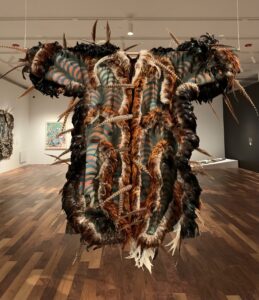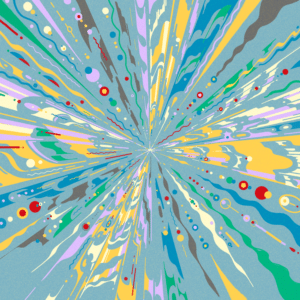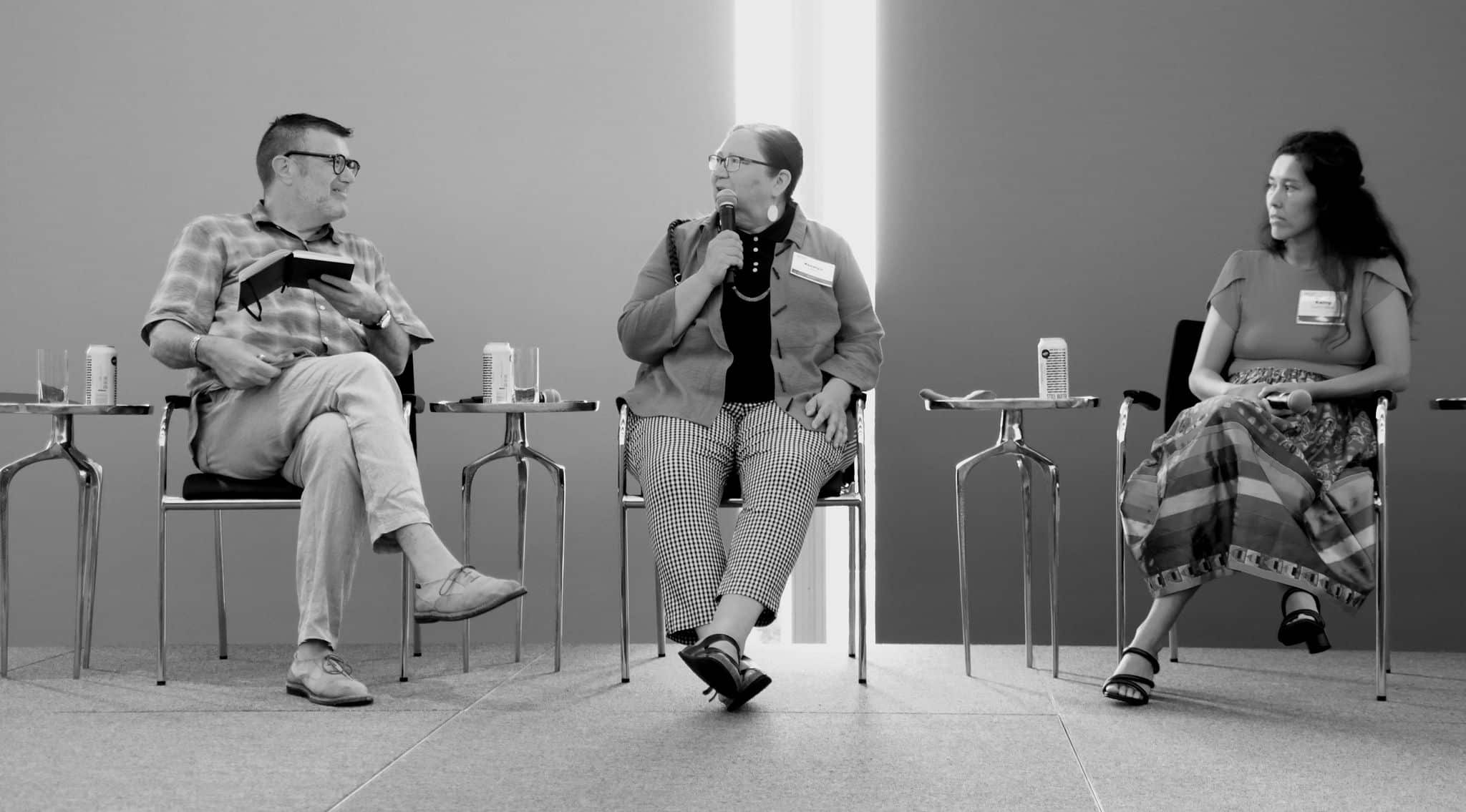“Science, as it’s typically presented, is very much through a Western lens. It’s considered objective, something above culture, but that’s untrue. If we want to see Indigenous students—and students from all backgrounds—engage more in STEM, we need to acknowledge the cultural biases inherent in how Science is taught.”
During a panel discussion on “Knowledge Making and Knowledge Sharing in the Sciences” at the Luce Foundation’s 2024 Clare Boothe Luce Program conference for women in STEM, Indigenous scholars Kathy DeerInWater and Rosalind LaPier shared their insights on integrating traditional Indigenous knowledge with Western Science. The conversation, moderated by Sean Buffington, Interim President and Vice President for Programs at the Luce Foundation, explored the challenges and opportunities that arise at the intersection of these two knowledge systems.
Two Hats of Knowledge
Rosalind LaPier, a member of the Blackfeet Nation and a history professor at the University of Illinois, Urbana-Champaign, initiated the conversation with a personal anecdote that illustrated the intricacy of navigating between Indigenous and Western knowledge systems. Growing up on the Blackfeet Reservation in Montana, she was raised by her grandparents, whose profound connection to traditional practices profoundly influenced her early years.
“My grandfather was a singer in the Blackfeet religious community, and my grandmother was what we would call a doctor in our society,” LaPier shared. “I spent my summers living off the grid with my family, disconnected from the outside world. During this time, I began learning about plants from my grandmother—what Science now calls ethnobotany.”
However, LaPier is also a physicist. She obtained a bachelor’s degree in physics from Colorado College before delving into further studies in environmental history. “I like to say I wear two hats—one as an academic trained in Western Science, and the other as someone who has learned Indigenous knowledge through formal apprenticeship with my elders. These are two very different ways of knowing, but they both shape who I am today.”
Kathy DeerInWater, a member of the Cherokee Nation and Vice President at the American Indian Science and Engineering Society (AISES), had a different upbringing in urban Tulsa, Oklahoma. Although she spent weekends with her father hunting on their family’s farmland, her exposure to Cherokee traditions was limited.
“I was raised in a predominantly white cultural household, so my connection to Cherokee culture wasn’t strong growing up,” DeerInWater explained. “It wasn’t until later in my career that I began thinking about how Science could incorporate Indigenous ways of knowing. I studied environmental Science, but I started to ask myself—what about Indigenous knowledge? How can we change the way Science is taught so that it’s more inclusive?”
Both women highlighted a common theme: they exist in two worlds, each with its own system of knowledge-making and knowledge-sharing. For LaPier, apprenticing with her grandmother in her twenties helped her understand the natural world in ways Western Science couldn’t fully capture. “It was a formal education, much like a university system,” LaPier said. “There was no osmosis—no mystical transfer of knowledge. I had to pay my grandmother every time she taught me, and I had homework. Eventually, after years, I graduated.”
Reconstructing the Scientific Lens
A vital topic of the panel discussion was the limitations of how science is taught in Western institutions. Both LaPier and DeerInWater agreed that the standard scientific method—often viewed as objective and acultural—reflects a narrow, Eurocentric worldview.
“Science, as it’s typically presented, is very much through a Western lens,” DeerInwater noted. “It’s considered objective, something above culture, but that’s untrue. If we want to see Indigenous students—and students from all backgrounds—engage more in STEM, we need to acknowledge the cultural biases inherent in how Science is taught.”
This disconnect is particularly glaring when considering why Indigenous people are underrepresented in STEM fields, despite significant outreach efforts. “We need to ask: who is being excluded from these conversations?” DeerInWater added. “How do we ensure they can see themselves in science, something that doesn’t force them to leave their identities at the door?”
LaPier echoed this sentiment. “In Indigenous cultures, knowledge isn’t simply passed down through generations—it’s learned through structured, intentional education,” she said. “Western science could benefit from understanding this, rather than assuming it’s the only valid system of knowledge production.”
Defining Indigenous Science
The conversation shifted to the 2017 March for Science, which aimed to uphold the role of science in policy-making during a time of significant political change in the U.S. LaPier, one of the organizers, spearheaded the event, leading to the creation of the Indigenous Science Statement. This manifesto challenges the idea of a singular, dominant form of science.
“We wanted to emphasize our support for sciences—plural,” LaPier stressed. “Science is not just one thing, especially not the version that originated in Europe and developed here in the U.S. We wanted to challenge the notion that there is only one way to generate knowledge.”
The Indigenous Science Statement gained momentum, gathering over 2,000 signatures and sparking a global discussion. “This was a crucial moment for us,” LaPier noted. “It allowed us to redefine what science could encompass—to assert that Indigenous knowledge systems are equally valuable and have existed for thousands of years.”
The Legacy of Western Science: Progress and Pain
During the discussion, Buffington raised an important question: Has the objectivity of Western Science, and its detachment from cultural and moral consequences, allowed it to be used for harmful purposes? Both LaPier and DeerInWater agreed that Science, while a powerful tool, has historically been used against marginalized communities, including Indigenous peoples.
“We can’t ignore that science has been wielded as a tool of colonization and cultural genocide,” LaPier stated. “For many of us, Science isn’t considered objective at all. It was used against our ancestors, and in many cases, it still is today.”
DeerInWater added that science is often disconnected from the cultural knowledge embedded in Indigenous communities. “Take pharmaceuticals, for example,” she said. “Modern medicine is built on Indigenous knowledge of plants, but the way that knowledge was extracted, narrowed down, and commercialized often removes the relationships and the cultural context that made it work in the first place.”
Both scholars emphasized that while Western Science has contributed to technological advancements, it is insufficient. “We need to blend these ways of knowing,” DeerInWater said. “Not to replace one with the other, but to recognize that together, they can create a fuller picture of the world.”
Toward a New Paradigm
As the panel drew to a close, LaPier and DeerInWater offered a hopeful vision for the future of Science. They both advocated for a more inclusive approach, one that honors Indigenous knowledge alongside Western scientific methods.
“There’s an urgency in my community to share what knowledge we can before it’s lost,” DeerInWater said. “We are seeing more elders come forward, more books being written, and more conversations happening. The barriers to access are falling, but we still need to change how we teach and talk about Science fundamentally.”
LaPier concurred, adding that the reconciliation between Western and Indigenous knowledge systems is a long but necessary process. “We’re not anti-science,” she stressed. “We’re simply advocating for a broader view of what science can be—one that respects and incorporates the wisdom of Indigenous peoples and other marginalized communities.”
Buffington summarized the essence of the conversation: “Science, in all its forms, is about understanding the world around us. But we must expand our definition of Science to include the many existing ways of knowing. Only then can we truly progress.”
The Clare Boothe Luce Program (CBL) was initiated in 1989 through a bequest by Ambassador Clare Boothe Luce. Since its inception, it has become the largest private supporter of women in STEM fields within higher education in the United States. The program has fostered diversity and inclusion in STEM by supporting undergraduate, graduate, and faculty women at various educational institutions nationwide. Over the past 35 years, the CBL program has distributed approximately $250 million through nearly 900 grants to over 200 colleges and universities. More than 70 of these grants have been awarded to minority-serving institutions. Through these efforts, CBL has supported over 3,500 women, helping to shape the next generation of female leaders in STEM. Learn more.
Sign up for updates
Explore Themes and Ideas































































